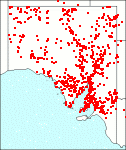Family: Fabaceae
Acacia ligulata
Citation:
G. Bentham, Hook. Lond. J. Bot. l :362 (1842)
Derivation: ligula (Latin)--a little tongue. Synonymy: A. salicina var. wayi Maiden, Trans.Roy.Soc.S. Aust. 32:277 (1908) ("Wayae"). Racosperma ligulatum (A. Cunn. ex Benth.)Pedley, Austrobaileya 2:351 (1987). Common name: Umbrella bush, Small cooba
Description:
Bushy, spreading, more or less rounded, compact shrubs 1-5 m high; branchlets slightly angular or ribbed, light green, smooth. Phyllodes linear or linear-oblong, 3-9 cm long, 3-10 mm broad, flat, rather thick, wrinkled when dry, glabrous erect or spreading, 1-veined and usually terminating with a small, hard, short oblique mucro, margins yellowish vein-like; glands small, one usually at the apex below the point and one on the upper margin below the centre towards the base. Inflorescences axillary and solitary or mostly in racemes, much shorter than phyllodes, consisting of 2-5 sparsely arranged heads; flower-heads globular, bright yellow, c. 20-flowered; flowers 5-merous. Legumes linear, 5-10 cm long, 4-10 mm broad, thick, hard, woody, light brown, margins thickened, more or less constricted between seeds, readily breaking into 1-seeded segments. Seeds longitudinal in legume, ovoid; funicle scarlet or yellow, often twisted with 2-3 folds below the seed.
|
|
Distribution:
|
Widespread and scattered all over the State and occurs in a number of different vegetation associations. In the northern areas this species is quite common on sand ridges and is often referred to as 'Sandhill Acacia'. Soils: associated with a variety of soils. Rainfall 150-700 mm. Also W.Aust., N.T., Qld, N.S.W. and Vic.
S.Aust.: NW, LE, NU, GT, FR, EA, EP, NL, MU, YP, SL, KI, SE.
|
Flowering time: August — November. |

SA Distribution Map based
on current data relating to
specimens held in the
State Herbarium of South Australia
|
Biology:
No text
Related taxa:
Acacia salicina is closely related but differs mainly in habit and legume characters. See treatment of Acacia ligulata by L. Pedley (1977), Chapman & Maslin (1991).
Taxonomic notes:
Leaf and shoot growth of A. ligulata was studied by Maconochie (1973). It showed distinctly seasonal patterns of new growth with the peak gain during the period of increasing daily temperatures. Highest losses also occurred then. Flowering in spring preceded new shoot growth.
The very widespread A. ligulata has only two mistletoes recorded from it in the State Herbarium. Amyema preissii, wire-leaved mistletoe is the most common. There are a few records of Lysiana exocarpi, harlequin mistletoe.
A. ligulata is a food plant for the larvae of the butterfly Nacaduba biocellata, Fisher (1978).
Descriptions and illustrations of the life cycles of the cossid moths, whose larvae provide witchetty grubs, is given by Tindale (1953). The principal Acacia hosts are A. ligulata and A. kempeana, the larvae living on or in the roots of the shrubs.
Isaacs (1987) and Cane (1989) report that A. ligulata is of 'moderate' importance to the Aborigines of the Western Desert as a source of seeds. It is a widespread species and the relative ease with which grinding stones can be found in sand hills with stands of the Acacia would indicate that it was used throughout its distribution. However Maslin et al. (1998) do not include it in their list of 47 species with potential for development as a food source.
Basedow (1925) describes the use by the Aborigines of ash from A. ligulata to mix with both Duboisia and Nicotiana when these two are chewed. The addition of an alkaline ash to enhance the extraction of alkaloids has developed in several countries e.g. use with betel nut in South East Asia and with tobacco in South America.
Yen (1989) considers the wood ash of A. ligulata was the favoured masticatory addition to 'pituri' (Duboisia) before chewing by the Aborigines of arid Australia.
Barr et al. (1988) and Latz (1995) report that the foliage of A. ligulata is used by the Aborigines for smoking treatments to relieve aches and pains.
Some of the problems in the taxonomy of A. ligulata are discussed by Pedley (1977).
For some time A. maxwellii, a Western Australian species, was sold in South Australian nurseries as A. ligulata (prostrate form). An illustration of both species is given and the critical characters used to separate them are listed (Whibley (1986). Both species are useful in cultivation.
A. ligulata is probably the most widespread woody shrub in South Australia.
A more recent paper by Chapman & Maslin (1991) reviews the A. bivenosa group to which A. ligulata belongs. The authors conclude that this very widespread and variable group can be divided effectively into a dozen species of which A. ligulata, A. cupularis and A. salicina occur in S.Aust. As a consequence A. cupularis is added to the flora of S.Aust. It was previously recognised as a narrow-leaved, substantially coastal form of A. ligulata. Most of the other species are restricted to Western Australia.
Cultivation:
A very hardy shrub useful in arid areas as a low windbreak and to assist in soil stabilisation. Fast growth rate.
Author:
Not yet available
References:
Source:
|

